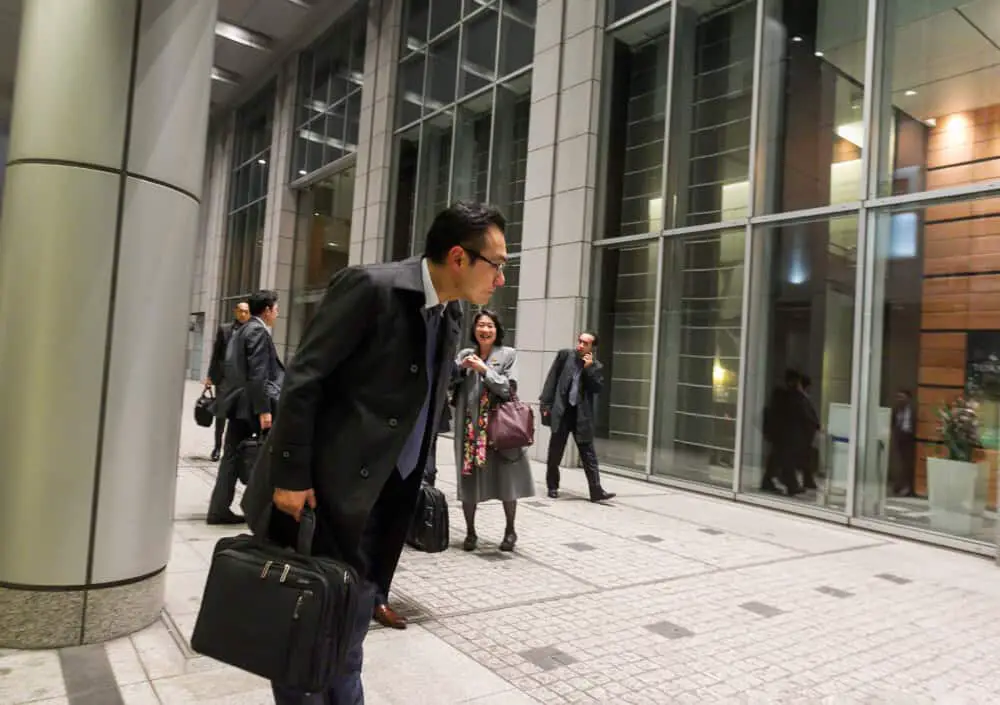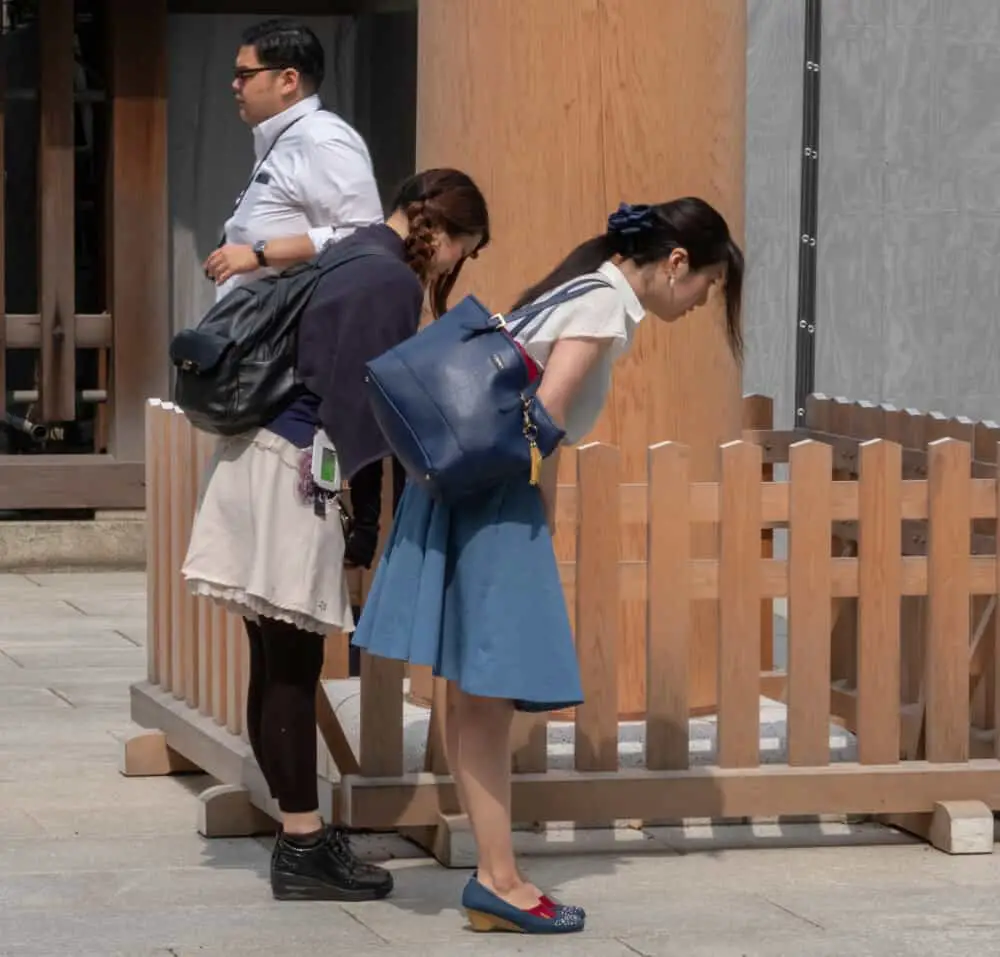For many of us, bowing doesn’t come naturally and knowing when it’s appropriate is often confusing for foreigners in Japan. It’s something that took me a while to get used to so I thought it’d be a good idea to make a simple post to pass on what I’ve learned over the years.
For Japanese people, bowing is the equivalent of a handshake. Bowing is used to both greet and say goodbye to people. In business, the angle of the bow can represent the level of respect they have for one another. When apologizing, Japanese people bow very deeply to emphasize how sorry they are.
The level of politeness in Japan is like a breath of fresh air but if you want to fit in it can feel a little stressful sometimes because it’s something we aren’t used to at all!
It’s something that is deeply ingrained in the culture and it’s not going away any time soon, so it’s important to have a general idea of the customs if you’re going to spend any significant amount of time in Japan!
When Do They Bow?
Basically all the time! If you’re walking around Japan for the first time as a westerner you’re going to notice it constantly.
Seeing a drunken party of older folks all enthusiastically bowing to their friend on the street isn’t something I was used to seeing!
The main reasons they tend to bow are;
- As a greeting – You’ll see this all the time. Generally, a slight nod of the head or a subtle bow between friends, people of all ages still do this in Japan. You might notice sometimes as you walk into a store, there’ll be a staff member welcoming and greeting people near the entrance.
- To say goodbye – Between friends, this is usually just a series of quick, short bows. However, if it’s between old friends or even business partners etc that have a lot of respect for each other it can be different. In those cases, I’ve seen that one will bow a little more and hold it while the other departs.
- As a thank you – A fairly quick, short bow is usually sufficient for this similar to that of the greeting.
- To apologize – The severity of the bow defines how sorry they are and it’s something you’ll see a lot in Japan. If someone accidentally bumps into you in the train station, don’t be surprised if they stop and bow to you. It’s comical if a waiter or waitress spills a drink or bumps into you here, you might get to meet the manager and witness the deepest bow you could ever imagine!
- If someone holds the door – This is a super common one. If you keep the elevator open for someone then you can expect to be greeted with a bow. Compared to other countries where a lot of people shy away from thanking people for being courteous, in Japan being polite is really appreciated.
How Far To Bow
An important thing to mention here is that you should always keep your back straight. In general, your arms will stay near your sides and your legs will stay straight too!
My first time ever attempting to bow in public should have been really embarrassing for me but I’ve got no shame.
I ended up bowing too deeply, bending my knees and getting a few chuckles from other people in the restaurant. Oh well. If you don’t know, you don’t know right?!
How deep you should bow really depends on the situation. While you’ll be forgiven by most as a foreigner for making mistakes (or not even following customs at all) making an effort to get this right will really help improve your daily interactions.
There are a few different ranges for bowing. If it’s between good friends or family, then a nod of the head is sufficient.
For a slightly more formal (but still informal) bow that’s used between work colleagues or people of a similar status to you in society for greetings, then a bow of around 15° is normal. This can also be used if you accidentally bump into someone and it’s usually the one you’ll see if you hold the door for someone!

The next level up from this would be the 30° bow. This is a lot more polite than the other two mentioned and is used by shop owners to customers and also in business settings where you want to show a little more respect… Much like the image at the top of this page.
When you’re bowing to your manager or someone with a much higher status than you, though, you’d better bring your A-game with a big ol’ 45° bow. It’s also the most normal bow for apologizing and should probably be your go-to in general. If you only take one thing from this post, just remember to bow at around a 45° angle and you’ll be okay!
If you ever do something horrible like fall on somebody’s puppy or spend too much time in the bathroom because you ate too much tonkotsu ramen (guess which happened to me) and now there’s a huge line waiting to use it… Then you need to apologize, quite dramatically.
For this, you’re talking anything up to 75°. If you fall on a puppy get all the way down there! Shame on you.
If a member of staff spills red wine on your new dress? Yeah, the manager is going to be pulling out this move too!
Bowing that deeply is also reserved for special meetings like meeting the emperor or even the prime minister. Just don’t eat too much tonkotsu ramen beforehand and you shouldn’t have any issues with that.
Should I Bow When I’m In Japan?
Overall the answer to this question is yes. Especially if you plan on living in Japan.
You don’t need to go overboard and memorize a thousand different situations and when to use each type of bow etc. In time you’ll see everything in action and work it out for yourself.
Just showing a basic level of respect for the culture will go a long way!
That being said, if you clearly look like a foreigner then you won’t be expected to make an effort to do anything and as long as you’re not being obnoxious you probably won’t upset anyone. In the bigger cities, they’ve seen enough travelers so they know what to expect.
A lot of people won’t know any better and that’s fine.
But you, you’re reading this post and you’re going to put aside any embarrassment and give it a shot. Maybe someday you’ll have a Japanese business partner or some Japanese customers so getting used to it now could help improve relations in the future.
Besides, apart from the initial awkwardness that you’ll definitely get the first few times, it’s not a big deal to us.
For people in Japan, though, it’s a big part of their lives and for a nation that generally keeps its cards close to its chest… A bow is worth a thousand words.

Do Japanese People Shake Hands?
No.
Handshakes are an awkward affair in Japan.
Because they realize most foreigners are uncomfortable with bowing or don’t know the right way to do it, they will usually make an exception.
Between Japanese people though, it never happens.
In fact, try it for yourself. If you have a Japanese friend, next time you greet them offer them a handshake… What is just a simple piece of human contact for us is clearly very unnatural for most Japanese people.
Much like bowing is unnatural for us.

